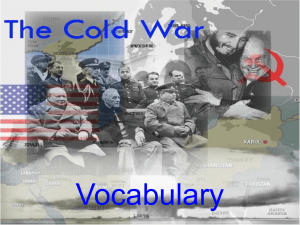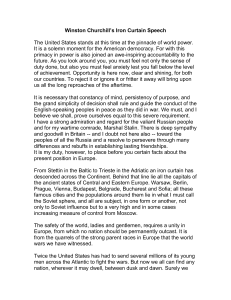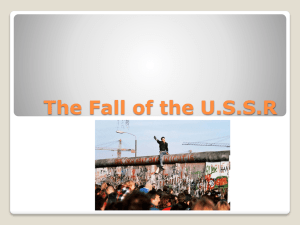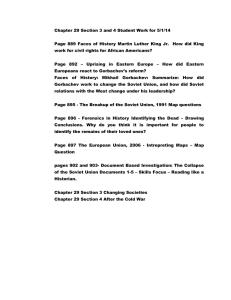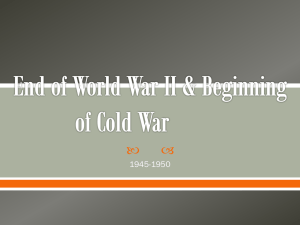Document 11300561
advertisement
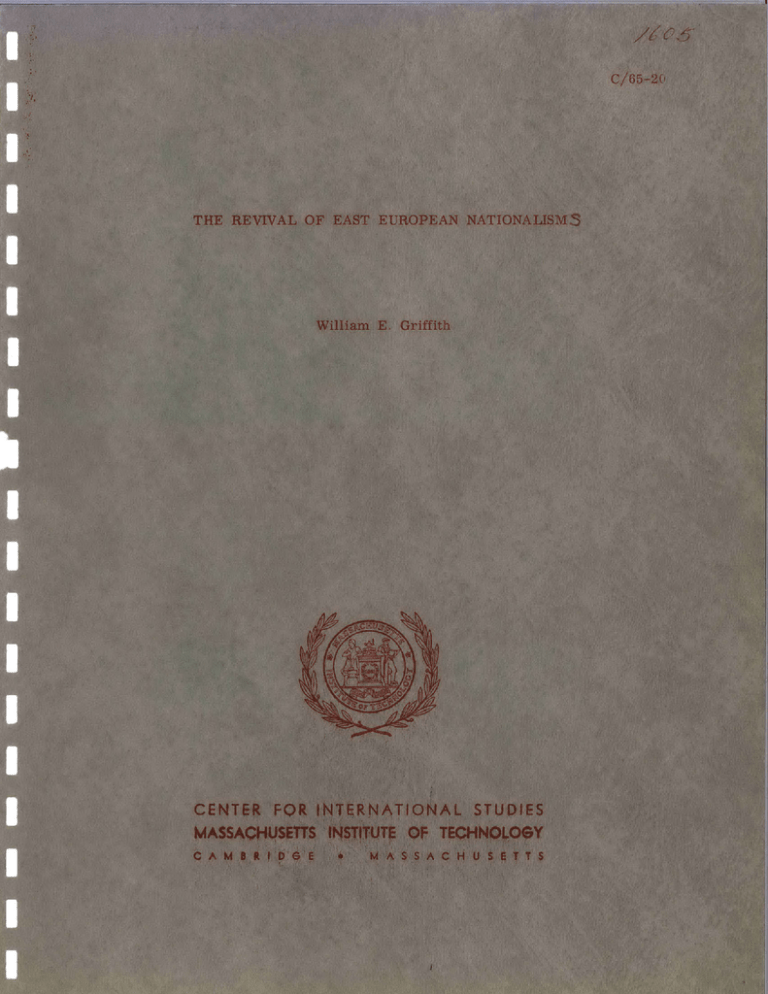
MASSACHUSETTS INSTITUTE OF TECHNOLOGY Center for International Studies C/65-20 July 10, 1965 THE REVIVAL OF EAST EUROPEAN NATIONALIEMS William E. Griffith Prepared for the Fifth International Conference on World Politics Noordwijk, Netherlands September 13-18, 1965 MuM m rsm m -io m m THE REVIVAL OF EAST EUROPEAN NATIONALISMS The slow but sure revival of nationalism in Eastern Europe can best be analyzed by considering its two major causes. first, changes in external influences and, second, domestic developments. T The primary external influence in Eastern Europe remains the Soviet Union. One of the resualts of the Second World War was that Eastern Europe fell into the Soviet sphere of influence; and, al- though to a lesser extent, it continues there until this day. At first, under Stalin, Eastern Europe increasingly became something close to a part of the Soviet Union. One of the tasks of his suc- cessors was to begin an imperial readjustment, in which Eastern Europe was the lesser problem; China, we now know, was the major one. Paradoxically, it was largely not in spite of but because of the 1956 Polish October and Hungarian Revolution that by the late nineteen fifties Europe. Jrushchev seemed. to be doing quite well in (We did not know then what we do now: doing badly with China,) Eastern he was already Khrushchev's program of de-Stalinization probably strengthened the Communist regime, at least for the pres- ent, within the Soviet Union, and it to some extent helped the Soviet Union in Eastern Europe. 1957, and again after 1960, it (For example, greatly between 1953 andI iproved rltions between Moscow and Belgrade) But for many reasons, including in particular the d.isintegra-3 tion of relations between Moscow and Peking, this reconsolidation in Eastern Europe of the late fifties proved to be short-lived3 (The point at which Moscow and Peking felt that a move toward a break rather than toward a reconciliation was probabie was, latest, in 3 1959, and probably In 1958 Although few in the West then realized thi Eastern Europe mcust have. the ieaders of Theyalso realized that, as a resuIt of the Sino-Soviet dispute and of the gradua in at the revival of nationalism Eastern Europe., the dream of Marx and, Lenin of proletarian inter- nationalism, already 1ransformed by Sta ininto Soviet national communism, was giving way tc the re-emergence of the interests of 1. Zbigniew Brzezinski., The Soviet Bloc, 2 nd ed. (New York: Praeger, 1961); Williaim E, Griffith ed . Comnism. in Europe . and II (Cambridge, Mass . The McLT. Press, 1964 and 1965) 2. Donald S. Zagoria, The Sinc-Soviet Confict 1956-l96i Princeton Tniversily Press, 1962); Alexander (Princeton. N.J InernaDallin with Jonathan Harris and Grey Hodne-tt Diverr in tional Communism (New York: Columbia University Press, 1969; The William E. Griffith, The Sino-Soviet Rift (Canibridge, Mass. O,riffith, "Sino-Soviet Relations M.I.T. Press, 1964); and. WilIam 1964-1965.," unpublished paper prepared for the Conference on SinoSoviet Relations and Arms Control sponsored by Harvard University under contract with the United States Arms Control and Disarmament Agency, Airlie House, Warrenton, Virginia, August 30-September )4 , 1965. -3the East European nations and states rather than those of the international Communist movement or of the Soviet Union itself. At the same time, and particularly after the Cuban crisis,3 Khrushchev (and., it now appears, his successors) were abandoning their dream of the continued. "permanent revolution from above" of Soviet society and. therefore of East European society as well. They apparently foresee its replacement by legitimization of the Communist regimes through economic accomplishments 4 give them more popular support; but one wonder, This will as many in the So- viet Union and Eastern Europe must wonder as well, what justification there is for Communist party rule when the economy not the party's "permanent revoluti.on," is the center of society. The Sino-Soviet dispute has led, along with increased nationalism in Eastern Europe, Soviet authority in to a gradual albeit unequal decline of the area.' This decline has increased the possibility of maneuver of the East European state and party leaderships both within the Sino-Soviet context and, with the West as well. 3. for many of them, One sees this most strikingly in the case Griffith, The S]n-Soviet Rift, pp. 8-11 and 60-66. 4. Richard Lowenthal, "The Prospects for Pluralistic Communism," Dissent, XII, I (Winter 1965). 5. Griffith, "Sino-Soviet Relations 1964-1965," g cit. of Romania, and one can even already see it to some extent in the case of such a hitherto Stalinist state as Czechoslovakia. Other factors originatng from the West have also been significant for East European developments great rise in One is certainly the the economic and. therefore cf the political power of Western Europe, and in particular the more active East European policies of France and West Germanyb United States victory in Secondly, there was the the Cuban crisis, which went far, partic- ularly in Romania, to convince the Communist leaderships in Europe that history is Eastern at least for the present probably not on the side of the Soviet Uniono The unity of the international CommuniSt movement is gone, split not only into two but many parts, and most probably irreversibly. The revival of Chinese territorial and, boundary ambitions vis-a-vis the Soviet Union make its reversibility even less li over, Mao Tse-tung and hs.- assocates are comitred to a long-range attempt to depose the Soviet Union as the head of the international Communist movement. This nation-state and ideological clash must seem even more irreversible to the East European leaders than it does to us. Finally, a whole series of ethnic and boundary questions is re-emerging in the Soviet Union, in China, and in Eastern Europe 6. Zbigniew Brzezinski, Alternative to Partition (New York: McGraw-Hill, 1965) 1Iore- itself. Two world wars started in Central Europe over still un- solved and now reintensifying ethnic problems. To the decline of Soviet authority and. the increasing power and influence of the West in Eastern Europe, there is added a declining fear on the part of the East European leaderships that they need fear Western, or for that matter, Soviet intervention. The successful defiance of Moscow by Romania has been only one of its results. A whole series of domestic East European developments reinforces these trends. II The three most important recent domestic developments in Eastern Europe are the general. economic growth, the increasing elite and mass nationalism, and the giving way of mass police terror to de-Stalinization and partial reform. These three develop- ments have resulted in, first, a somewhat greater identification of the East European regimes with the peoples of these countries (a trend intensified by the regimes' declining identification with the Soviet Union) and, secondly (in addition to a declining fear of Western intervention) hold their authority. their declining need of Soviet troops to upHowever, there remain limits within which Soviet hegemony would probably still be asserted--specifically, as in Hungary in 1956, withdrawal from the Warsaw Pact or collapse of a one-party Communist regime. There was in known as the thaw, Eastern Europe from 19 3 until 1956 a period which. cuiminated in Hungarian Revolution, of Communist power. and was reversed by the giving way thereafter to a reconsolidation Since about 1960, and more clearly since 1962, a new thaw has begun in Eastern Europe. there in the early fifties, more inclusive: As compared with the thaw this new thaw is first geographically with the exception of Albania and Poland, cludes to a greater ar lesse Secondly, it is les and economic in inspiration. it in extent all East European states. plitical ad literary and more nationalist Thirdly it centers less among crea- tive Literary and revisionist intellectuals and more in the Communist party and economic apparats The new thaw .ineconomics has been caused primarily by the growing complexity and Inefficiency of the East European economies. This is most clearly the case with respect to East Germany and Czechoslovakia, states, by far the mt industrialized of East European their economic liberalization is ring, more slowly, in much like what is the Soviet Union itself, occur- The increasing development and complexity of their eccnomies makes increasingly necessary, if only for the sake of efficiency, major reforms in 7 William E. Griffith, The East European Thaw, (Cambridge, Mass.,: The M.L TO Press, forthcoming). 8. Paul E. Zinner, University Press, 1962). Revolution in 1953-1956 Hungary (New York: Columbia ( 7central planning in the direction of decentralization and of the introduction of a rational price system and of something close to a market economy. This problem, in turn, has led to an increasing conflict between the economic and, managerial technicians, whose primary goal is apparatchiki, ful in economic efficiency, and the old-line party whose coercive and, propagandistic policies were use- the period of rapid economic growth before a certain plane of industrialilzation was reached but whose same skills are increasingly counter-producti've in increasingly complex economies. This economic thaw was set off, or at least was greatly aided., by the beginning of the so-called Liberman discussion in the Soviet Union and. by the worsening of economic conditions in Czechoslovakia and East Germany. The proposals for decentralization of Professor Liberman of Kharkov, Pravda in first September 1962. introduced publicly in an article in involved decentralization and greater priority for consumer goods.l7LO They have been fairly rapidly ac- companied by, and, In part have probably given a convenient excuse for allowing to break through, similar but more far-reaching developments in Eastern Europe. These developments have been accompanied 9. John M. Montias, "Communist Rule in Eastern Europe," Foreign Affairs, XLIII, 2 (January 1965), pp- 331-348. 10. Marshall I. Goldman, "Economic Controversy in Union," ibid., XLI, 3 (April 1963), pp. 498-512. the Soviet some sh 1 It by E paW tcar ly Western Europe. by the East Europea regiie tb uugh and ac tin more important than, al the revival of hiough tn part induced by, that of their and, third, as before Eurpean Cmunist leaders now recognize that neither the 5' tsare the d - ta' re raewonk the SovTer of power. resl. iIn somf differences f gso p!ar a second, on the part of the Comimunist leaders ineraiea oau suvemnt nr t naturally revives vng Easi Eurcpean oatnalta-ms are often rutuall y hos+ile T'he Ea-s on first, stand. out *rde.,sses of the populat ion fE Fhe r .acens; aant p n Finally, second major fac- th st elemeCts, enemic in Eatern Europe and it naiali sm i na onast a development encouraged Three imfportant points This new thaw, we f ood of tourists of East Europec the nationa J trn now particu- - attempt to push forward. much more tegratior apidy t-i Europe, Iargeiy for economic reasonsa a ocked Khruhchtev" Buchares tor in as- by an increasn a tarl v y Rmas from t-he We-7t trade toward. Wesern Eropean ': Since -ny Eas 3, : te pc: 1,: European sate Un-on but their Once these nationalist or, in Romania, t hthr developments then become with, which even partially opposes the So:e' Uninr cani no lnger as compleely as before rely upon ii Gri ffith, The Sinc-SovietRift, pp1 137-142 and 185-186; Bas IEackground and Origin-s of the Rumanian and John Michael Mont Dispute wi.th Ccmecn," Sovet Studies, XVI, 2 (October 1963) pp. 12h15'> Soviet support, it must therefore necessarily try to generate more popular support at home and also, itself if only minimally, to reinsure with some other external power. where the power is China, with all With the exception of Albania, other East European states this has resulted in the improvement of relations with the West. The combination of the necessity for more popular support at home and for improved relations with the West tends to result in concessions to the population of the country concerned and to a gradual decline in the domestic and external extremism of the party apparat0 The new thaw in Eastern Europe has not been confined only to nationalist and. economic developments. from country to country, consid-erable changes also in sphere, both with respect to decline in ist There have been, realism (for example, varying the cultural the rigid limits of social- a greater tolerance for abstract art) and also to a greater degree of Western cultural influence at both the elite and mass levels: creative literature, for example, and Western jazz. III Turning to the individual East European countries, first attempt to set up some categories of analysis, one must Any categories, for eight countries as increasingly different as these eight are, always oversimplify the analysis, but there do seem to be some general, approximate common pa t terns. -10- First, one may consider the leadership's domestic policies-, whether or not it is neo-Stalinist (Iceo, rigid) or reformist or even revisionist, and. in addition, the direction in moving. which it is Second, one may consider its policy toward the West:. whether it is conciliatory or hostile. Third, one may consider its attitude toward the Sino-Soviet dispute, the major current foreign policy factor affecting East European countries; within this context one can consider a regime as either moderate, that is to say, opposed to a total and definitive break between Moscow and Peking, or extremist, that is to say, in favor of such. a break or, minimally, in favor of the most extreme Soviet moves toward it. First, with the partial exception of Romania and YugoslaviaI there has been no major change in the allegiance of East European states with respect to the Sino-Soviet dispute since 1.960. have been, however, There They may be summed significant minor changes. up by saying that Soviet influence in Eastern Europe has consistently declined, and the influence of other Communist parties, particular the Chinese (in Aalbania only), decreasingly) the Yugoslav has Increased. in the Italian, and (although Above al1, the relative independence of the East European parties has increased since about 1959; indeed recent research has indicated that the Romanian devia12 tion can be dated back in published material to 1958. Second, since 1960 the differentiation among these states has greatly 12. Montias, "Background and, Origins," ]cc cit I a increased. in Third, although there has nct yet been a formal split the international Communist movement there has been a de facto break between the Soviet Union and China, a development which is probably the major foreign policy factor influencing the decisions of all East European leaderships. IV In considering developments states, in the Individual East European one may best begin from the south, with the two most excep- tional ones: Albania and Yugoslavia. about Albania is that for the first the Mongols in The most significant thing time since the withdrawal of the fourteen t h century, a European state is the influence of a major Far Eastern power: under not just a traditional Far Eastern power, not even just a modernizing expansionist empire such as Japan, but a major modernizing Asian power with international revolutionary ambitions. ance of Moscow and its The reason for the Albanian defi- gradual 1957-19 60 shift to Peking was the Albanians " fear and hatred of Yigoslavia, nearly succeeded in which twice before had not only deposing but--as things go in that part of the world.- murdering the Leadership of the Albanian Communist party. Enver Hoxha and Mehmet Shehu naturally had no inten- tion of running such a risk again. convinced, In 1955, Hoxha and Shehu were the Soviet Union had been prepared to sacrifice them to its greater interest in a rapprochement in Yugoslavia; and as SinoSoviet differences deepened in the late fifties they believed that Khrushchev was preparing to do the same thing again. Their choice-- to ally with Peking agains t Moscow-was therefore natural and rational; and so far It True, has proved on balance quite successful. the economic damage resulting from the loss of Soviet aid was very great in Albania--but that was so in China as well, and the damage is both countries. now gradually being repaired in The Chinese continue to support Albania, reason why they will not do so in and there appears to be no the future. (Whether Albania is following a policy significantly different from China, within an over-all alliance, remains doubtfulo ) West have been mninimal, in Albanian relations with the spite of some anticipation in the early sixties that such reiations m:.ght deve.lop; but Tirana has become increasingly a center for pro-Chinese and pro-Albanian dissidence in Western European communism. Finally, Albania is significant be- cause when direct overt Sino-Sov;tet pclemiCs decine, month after the fa. the of Khrushchev, one can tell from what the Albanians are saying what the Chinese are thinking: resumption of Albantan attacks made clear that Sino-Sovie Yugoslavia Is as in the rapid upon the new So viet leadership first reconciliation was not in far more complicated. the cards 13 Staiin"s 1948 break with Tito--Tito most reluctantly became a heretic-realiy began the revival of nationalism in Eastern Europe The latest Moscow-Belgrade 13. Wil) iamn E. Griffith,, Albania and the Sino-Soviet Rift (Cambridge, Mass.-: The M.L T. Press, 1963), passim and. "Sino-Soviet Relations 1964-1965, " o it'. -1.3rapprochement probably began secretly in 1958-1959, concomitantly with the deterioration of Sino-Soviet relations; it became public by 1962. By 1965 Yugoslav and Soviet foreign policy were largely aligned, particularly with respect tc the West and underdeveloped areas. There were internal Yugoslav reasons why Tito felt it desir- able to allow his relations with the West to worsen and to improve his relations with Moscow,, First, the Yugoslav economy tends to move cyclically from relative prosperity to near-crisis. and 1961, and again by 1965, it was in crisis as a result of bad harvests and industrial, and balance-of-payments Second, Yugoslavia,, like the Soviet Union,, is anti-Chinese. in Third, Tito is In 1960 over seventy. difficulties. both anti-German and The succession crisis Yugoslavia will probably be the most difficult of any East European country. Yugoslavia has not one nation but six: the Serbs, the largest; the Croat, farther to the north; the Sloveni- ans, the farthest north of alil and to the south the Montenegrins, Macedonians, and Albanians (half as many as those within the Albanian borders). Nationality tensions in Yugoslavia have caused more blood to flow than anywhere else in Eastern Europe. These tensions were submerged. by the Communists, in part genuinely, as the result of popular recoil from the fratricidal slaughter of the war, and in part also because the Communists simply suppressed them by police measures. emerging rapidly, particularly because, in They are, however, re- spite of very large-scale investments in Yugoslavia, the underdeveloped areas in the south and east of the economic growth of Slovenia and Croatia has been so great that the economic gap between the north and south is than it was in 1939. Furthermore, greater the immense investments in the south are made at the cost of the Croats and Slovenes to the north, a fact which in turn gives an economic as well as a religious and. historical base to the nationalities tensions. It Tito is is often said in Belgrade, the only Yugcslav. ceeded in and only half jokingly, that Half Croat and half Slovene, he suc- identifying himself in the popular consciousness with the idea of Yugoslavia. But he is Communist who has. almost the only leading Yugoslav The two major contenders for the succession, the Serb Rankovic and, the Sicvene Kardeij, are thought of by the people not as Yugoslavs but as a Serb and a Slovene,, assume, therefore, that nationaiti:es tensions in One must Yugoslavia will greatly increase after the depart.ure of Tito from the scene. In the last year there has been a Counteroffensive of the Croat and Slovene liberals against Belgrade 's attempt to crack down, which occurred, rapprochement, in in part .1961-1962. tellectual ferment in of Slovenia in writers in in order to further the Soviet-Yugoslav There has been very considerable in- Croatia and Slovenia, resulting in the case the arrest and imprisonment of several rebellious the Slovenian capital, L jubljana, and in Croatia in Mihajlov case. the There has been a strong drive, led by the Communist leader of Croatia, Vladimir Bakaric, to bring about more economic I 5- decentralization, thus furthering the autonomy of Slovenia and Croatia. It would appear that the 1964 Congress of the Yugoslav Party was a victory for the liberals. Most recently, the worsening eco- nomic crisis has led to more econcmic decentralization at home but is also in large part responsible for the by now almost complete rapprochement with the Soviet Union, Yugoslavia s only remaining source of foreign aid. slavs would be in As to the Sino-Soviet dispute, the Yugo- favor of a total break if they felt there were a serious danger of a rapprochement between Moscow and Peking. Since there is not, they now prefer not to have a total break in order to retain greater freedom of maneuver, Among the more rightist or reformist East European regimes, Poland is exceptional, Although the major gains of 1956 have been retained (the end of agricultural ccilectivization and of secret police terror, the uneasy but cont:nuing modus vivendi with the Roman Catholic Church, and Polish autonomy from Moscow), Gomulka has otherwise, and (in partic ularly in part) economics, the more peripheral areas of culture been retreating from liberalization. Polish "retreat from October" has many causes- The GomuXka's dislike for intellectuals, his lack of concern for the West, the increasing 1.4. Griffith, The Sinc-Soviet Rift, pp. 182-183; Viktor Meier, "Yugoslav Communism," in Griffith, Communism in Europe I, pp. 19-64, and his running coverage in Neue Zircher Zeitung; and Anatol Shub, "Moscow Summer, Belgrade Winter. The Case of Mihajlo Mihajlov," Encounter, XXIV, 6 (June 1965), pp. 8,-91. power of the more extremist party group known as the "Partisans.," the economic stagnation of the country, and in to be a downward cycle in Polish affairs. freest country in Eastern Europe. general what appears Poland is Nevertheless, it no longer the is the only East European country except Yugoslavia where agricultural collectivization remains ended. and where the Roman Catholic Church has such power. The Poles are unenthusiastic about a Sino-Soviet break; but their dependence on the Soviet Union (a the way, of any Polish government, dependence, by because of the necessity of protecting their western frontier) forbids them to defy the Soviet Union) Perhaps the greatest changes in any East European country in the last five years have occurred in Hungary. Kadar, in In the first place, 1956 considered. one of the greatest quislings of history, has performed an amazing job of self-rehabilitation: achieved relative popularity country in Eastern Europe, in Hungary today Is probably the freest terms of cultural relaxation, travel, and the end of mass secret police terror, tural collectivIzation continues, True, foreign agricul- but the regime has introduced a kind of sharecrcpping which has greatLy modified it. relations with the West, he has now Hungarian particularly with West Germany, have 15. Hansjakob Stehle, "Polish. Communism," in Griffith, ed., Communism in Europe 1; Anatol Shub from Warsaw in The Washington Post, June 11 1,965 and H. 'ordon Sk-illing, Communism National and International (Toronto: The University of Toronto Press, 1964), pp. 37-52. improved and at the same time the rise of Romanian nationalism in Transylvania (the northwestern part of Romania, where more than one and one-half million Hungarians live), has led to a reappearance of Hungarian nationalism within Hungary, concentrated., as so often before, on the Transylvanian question. As to the Sino-Soviet dispute, Kadar also does not really want a Sino-Soviet break, but he still depends too much on Soviet economic aid and troops to be able to defy Moscow. Nevertheless, / / both Gomulka and Kadar demonstrated after Khrushchev's fall their dislike for the manner in which it had been carried out: their attitude toward the Soviet Union has thus become, within these narrow limits, somewhat ambivalent. What until. recently one would have called the leftist or extremist leaderships in Eastern Europe, the East Germans, the Czechs, the Romanians, special cases. and, the Bulgarians, have also become very To begin with the most exceptional: East Germany-- neither a state nor a nation, neither German nor democratic nor a republic.o Its Communist regime probably never can be consolidated as long as West Germany remains so prosperous and powerful. Ulbricht remains the most hated Communist leader in the world. is probable that, if It the Soviet troops were withdrawn and the popu- lation of East Germany were convinced they would not return, Ulbricht and his associates would be hanging from lamp posts within a few hours. Nevertheless, as a result of the Berlin Wall and the end of the East German refugee flow, there has been a certain improvement 418 in the Pankow regime's position. Because of this, because of the necessity of improving economic productivity and therefore the necessity of economic reforms, and. because of pressure from Moscow, there has been since the summer of 1962 a certain limited liberalization in East Germany, primarily in econoncs, moving toward more decentralization and a greater role for the market and rationalI prices. There have been also improvements in food supply, in the situation of the youth, in the system of justice, and, to some extent, in the cultural field.I In foreign policy--and this for East Germany means the problem of German reunification-the situation remains unchanged. Ulbricht strongly fears any Soviet rapprochement with West Germany; he must therefore have been rather disquieted in Khrushchev's power. break. the last months of Ulbricht does not want a total Sino-Soviet He would like to be able to afford to play a little with the Chinese, with some of whose policies he sympathizes; but his total dependence on Soviet troops, he is in doomed, his conviction that without them means that he remains in domestic policy as well, foreign policy, and largely a servant of Soviet policy 16 Even so, he tries to be no more hostile to the Chinese than Moscow insists upon. Of the previously neo-Stalinist regimes, by far the greatest internal changes have occurred in Czechoslovakia. There internal 16. Carola Stern, "East German Communism," in Griffith, Communism in Europe II; and, Melvin Croan, "The German Problem Once Again," Survey, No. 55 (April 1965), pp. 171-176. policy seems now to be in transition from extremist to liberal. The Czechs have always been cautious. was in 1620; and. it is Their last successful revolt unlikely, given their long experience in surviving, that they will soon revolt again. But the Czech economy is a very major crisis. very developed, and by l962-1963 it was in The rate of economic growth in Czechoslovakia in 1963 was -Ol per cent, almost a record for the world-if one excepts Indonesia. Be- cause of this economic crisis, because of the inability of this highly-developed country to grow with the system of central planning, the political leaders of Czechoslovakia, and particularly its head, Antonin Novotny, have reluctantly felt compelled to listen to the advice of their economists and to move toward major economic 17 decentralization 1 At the same time and also because of their need for more foreign currency, they have felt forced to allow a flood of Western tourists to visit the country. been a considerable increase in vakia, There has also cultural freedom within Czechoslo- as well as some signs of the revival of Czech-Slovak rivalry which plagued the first interwar Czechoslovak Republic. In spite of all this, Novotny, who was the Stalinist leader of Czechoslovakia, has survived. True, he has disposed of many of his associates, and perhaps only by throwing overboard this ballast has he been able to save himself. But at the present time not only 17. John Michael Montias, "A Plan for all Seasons," Survey, No. 51 (April 1964), pp. 63-76; and Skilling, o2 cit0 , pp. 102105. -20- has he survived, but he was apparently sufficiently confident of his own strength so that after the fall of Khrushchev he indicated more public displeasure than almost any other East European leader. He reportedly refused to go to Moscow for the October Revolution celebration, has, the onl y East European Leader whc did so--a step which of course, given him greater popularity in Czechoslovakia may well, the country. slowly and cautiously, try to imitate Romania's new foreign policy, at least in partc 0 , There have also been stirrings, albeit of a different kind, in Bulgaria. The Soviet Union is Tsar was In 1880: it back in the Balkans where the can rely at most on Bulgaria. Bulgaria has also carried out extensive decentralization of its economy, and some Bulgarian econoini sts have exhibited a certain degree of ideological economic revisionism Much more importantly, in the spring of 1965 the Sofia regime unccvered and crushed a politico-military conspiracy against it-the first time that any East European Com- munist army was even partially involved in an antiregime conspiracy. The conspirators were basically nationalist in pro-Chinese, not and most of them had a wartime partisan background. Although crushed, regime. orientation, the conspiracy showed the weakness of the Zhivkov Out of tradition, out of the weakness of the present Bul- garian regime, out of the need it 1.8. Viktor Meier, Zuircher Zeitung, June 6, feels for protection against the "Die Tschechoslowakei am Kreuzweg," June 2r, and July 8, 1965. Neue -2.1- rebellious Yugoslavs and Romanians, Bulgaria remains, as it did in 1880, a satellite of Russia; but the unsuccessful coup showed that even in Sofia Soviet control is neither certain nor necessarily permament. 19 Romania is Europe. by far the most interesting country in Eastern As has been pointed out before, recent research has indi- cated that the beginnings of Romanian dissent go back to 1958. The documentation available for this early period is entirely economic; it concerns the Romanian rejection of multilateral economic integration within CMEA, a mcve caused primarily by Bucharest's justified fear that it would profit only the countries already industrialized, East Germany and Czechoslovakia, while Romania would remain prima- rily a source of raw materials, an economic colony of the Soviet Union and of East Germany and Czechoslovakia, which the Romanians are no more likely to accept than is nized underdeveloped country. any other economically colo- Romania is by far the wealthiest country in Eastern Europe, not only because of its timber and agricultural products but also because of its very major resources in oil and natural gas. build its It has therefore substantial resources to own industrialized economic base, and it is determined to use them to do so, 19. J. F. Brown. "The Bulgarian Plot," The World Today, XII, 6 (June 1965), pp. 261-268; Viktor Meier, "Die Verschworung in Bulgarien," Neue Z"rcher Zeitung, April. 29, 1965, and "Der Umsturzversuch in Bulgarien, " ibid, May 2, 1965; and o k., "Undurchsichtige Vorg'inge in Bulgarien," ibid., April 23, 1965. -22- The Romanian differences with the Soviet Union have not been only economic; they have historical and political causes as well. The Romanians have always been anti-Slav and anti Russian over, in 1940 the Soviet Union unilaterally annexed the northern part of Romania, Bessarabia and Bukovina, in More= Romanian hearts. of Romania is Furthermore, a move which sti rankles the present Communist leadership alriost entirely "native"; it is comp ed of people who did not spend, the interwar period cr the Second World War In Moscow, and it is almost entirely ethnicaly Roranian in origino n (Most top Hungarian, Ukrainian, or Jewish Communists were purged 1952-1957,,) in The Romanian Communist leaders saw their opportuni t y the Sino-Soviet dispute; and they have kncwn how iantly between Moscow and Peking. m (Such dancing on a tightrope is nothing new in Romanian history: in the First and Second World Wars at just the right tim the Romanians changed sides and wth very favorable results,) As became publicly and totally clear declaraton of i its April 1964, the Romaniran leadership has adopted, a modified national communism. Its partial break with Moscow ha- ledt of its relations with the West and with. its oI release, for example, of political prisoners degree of cu.tural liberalization. an improvent popuatin, and to an increasing Nevertheless, Romania s naion al communism fundamentally reflects the desire of brlantly, treacherously5 to the if successful bureaucrats to run their own affairs and, to play with all sides for their own benefit: to have god relatio -23with Peking, Moscow, Belgrade, Bonn, Paris, London, and Washington-with everybody, that is, except Hungary, where the Transylvanian problem makes this impossible. In spite of Romania's refusal to attend the March 1965 18-party conference, Moscow remain correct, its relations with and those with Belgrade and Warsaw excellent. The Romanians have now probably the best position they have ever had in their history, immediate neighbor They can balance not only against their and against the West on the one hand and the Russians on the cther, but they can also balance the Russians against the Chinese2 Finally, what of the most recent developments? After Khru- shchev's fall quite a few of the East European parties, the Czechs, the East Germans, and the Hungarians, the Poles, publicly indicated their dislike for the way his removal was handled, a dislike made clearest by Novctn"s refusal to go o Moscow. clear that Khrushchevxs fall and h successors' sion, It is increasingly indecision, divi- and dilemrma in Vietnam have greatly dimini shed the already 20. Griffith, The ino-Soviet Rift, pp. 137-141 and 185-186 (with bibliography); Mont:ia , "eIgrcund and Origins of the Rumanian Dispute with Comecon " loc cit ; J. F. -Brown, "Eastern Europe," Survey, No. 54 (J anuary 1965 reprinted in Leopold Labedz, ed., Internationa Communism After Khrushchev (Cambridge, Mass -, The M.I.T. Pres s, 1965, pp. 6 ; k ristian Kind, "R' maniens industrielles Aufbauprogramm ," Neue Zurcher Zeitung, Tune 11, 1964; and Viktor Meier. "R'Omaniens Selbstndigkeit im Ostblock," May 9, 12, 15, 19, 22, 2, 1965 and "Annaherung Bukarests an Prag, " ibid., May 11, 1965- declIning Sov, et prest What, Eurcpean ge in Eastern Europe. then, are the factors which characterize the East _- -day? c deciline cf mass easier for The downgrading of the secret police and the error both within and without the party make it Ihe intelligentsia, ones, and particularly managerial and ecocnoic ehrder for the party apparat This. plus economic devel> lead tow ard the decline of the decisive opment, party apra over various competing elites. limits to this .teralization; oth hcw far l and It is relizat-ion has gone and. There are, impcrtant to 'ts til mt are nct a u nwilling ed with the Scviet Union rae t rmain sa The in any effctive and ugoslav.a military sens id.eoogy and a o reCd.fine that in part it also ideolog nit eeonya and of a one-party state, b t-as, for example, comCes rev'isionist and thus in not allow th the end of Commuone can keep th the Yugos.lavs did- ncreasingly likely its neighbors. Then there is decline in he Scvi;ets prota- Yet Altania Sove t Union wuld proval abanonnt of Marxis-Leninist to infect nderstand at least pcse the ques t ion ,whether the Romanian and :n. mus owIca of to allow the derunciation of a forma: w the Soviet Union- al e of th limis! Aarth 13 oaan Revo1 utIon demonstrat ed. bly are superiority the evolution within the apparat itself: the the power of the agitprop and of the purely party apparatchiki, the increase In the power of econcric technicians, and, he moving toward power of a new, postwar generation. The -25Communist elites of Eastern Europe are increasingly modernizing, anti-Soviet, nationalistic, anti-Western, and anti-democratic. What was Communist totalitarianism in Eastern Europe is becoming more authoritarian in character. tional. Mass terror is becoming excep- There are greater areas of autonomy for non-party elites. There is a gradual change from the atmosphere of ideological struggle and revolution from above to more pragmatic and economic goals. Finally, there is increased independence from Moscow. This re-emergence of national identities in Eastern Europe will not soon probably produce democracy. bly lead to some, It will, however, proba- albeit limited,, liberalization, but above all the nationalization and bureaucratization of the East European dictatorships. to

